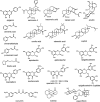Medicinal plants and their isolated phytochemicals for the management of chemotherapy-induced neuropathy: therapeutic targets and clinical perspective
- PMID: 30852764
- PMCID: PMC6593128
- DOI: 10.1007/s40199-019-00255-6
Medicinal plants and their isolated phytochemicals for the management of chemotherapy-induced neuropathy: therapeutic targets and clinical perspective
Abstract
Background: Chemotherapy, as one of the main approaches of cancer treatment, is accompanied with several adverse effects, including chemotherapy-induced peripheral neuropathy (CIPN). Since current methods to control the condition are not completely effective, new treatment options should be introduced. Medicinal plants can be suitable candidates to be assessed regarding their effects in CIPN. Current paper reviews the available preclinical and clinical studies on the efficacy of herbal medicines in CIPN.
Methods: Electronic databases including PubMed, Scopus, and Cochrane library were searched with the keywords "neuropathy" in the title/abstract and "plant", "extract", or "herb" in the whole text. Data were collected from inception until April 2018.
Results: Plants such as chamomile (Matricaria chamomilla L.), sage (Salvia officinalis L.), cinnamon (Cinnamomum cassia (L.) D. Don), and sweet flag (Acorus calamus L.) as well as phytochemicals like matrine, curcumin, and thioctic acid have demonstrated beneficial effects in animal models of CIPN via prevention of axonal degeneration, decrease in total calcium level, improvement of endogenous antioxidant defense mechanisms such as superoxide dismutase and reduced glutathione, and regulation of neural cell apoptosis, nuclear factor-ĸB, cyclooxygenase-2, and nitric oxide signaling. Also, five clinical trials have evaluated the effect of herbal products in patients with CIPN.
Conclusions: There are currently limited clinical evidence on medicinal plants for CIPN which shows the necessity of future mechanistic studies, as well as well-designed clinical trial for further confirmation of the safety and efficacy of herbal medicines in CIPN. Graphical abstract Schematic mechanisms of medicinal plants to prevent chemotherapy-induced neuropathy: NO: nitric oxide, TNF: tumor necrosis factor, PG: prostaglandin, NF-ĸB: nuclear factor kappa B, LPO: lipid peroxidation, ROS: reactive oxygen species, COX: cyclooxygenase, IL: interleukin, ERK: extracellular signal-related kinase, X: inhibition, ↓: induction.
Keywords: Chemotherapeutic agents; Clinical studies; Inflammation; Medicinal plants; Neuropathy; Pain; Phytochemicals; Phytotherapy.
Conflict of interest statement
Authors declare that they have no conflicts of interest.
Figures





Similar articles
-
Herbal medicines and chemotherapy induced peripheral neuropathy (CIPN): A critical literature review.Crit Rev Food Sci Nutr. 2017 Apr 13;57(6):1107-1118. doi: 10.1080/10408398.2014.889081. Crit Rev Food Sci Nutr. 2017. PMID: 25849070 Review.
-
A review of complementary therapies with medicinal plants for chemotherapy-induced peripheral neuropathy.Complement Ther Med. 2019 Feb;42:226-232. doi: 10.1016/j.ctim.2018.11.022. Epub 2018 Nov 27. Complement Ther Med. 2019. PMID: 30670246 Review.
-
Plant-derived medicines for neuropathies: a comprehensive review of clinical evidence.Rev Neurosci. 2019 Jul 26;30(6):671-684. doi: 10.1515/revneuro-2018-0097. Rev Neurosci. 2019. PMID: 30768427
-
Integrative Herbal Medicine for Chemotherapy-Induced Peripheral Neuropathy and Hand-Foot Syndrome in Colorectal Cancer: A Systematic Review and Meta-Analysis.Integr Cancer Ther. 2019 Jan-Dec;18:1534735418817833. doi: 10.1177/1534735418817833. Epub 2018 Dec 10. Integr Cancer Ther. 2019. PMID: 30526124 Free PMC article.
-
Analgesic effects of medicinal plants and phytochemicals on chemotherapy-induced neuropathic pain through glial modulation.Pharmacol Res Perspect. 2021 Dec;9(6):e00819. doi: 10.1002/prp2.819. Pharmacol Res Perspect. 2021. PMID: 34676990 Free PMC article. Review.
Cited by
-
The Therapeutic Potential of Antioxidants in Chemotherapy-Induced Peripheral Neuropathy: Evidence from Preclinical and Clinical Studies.Neurotherapeutics. 2023 Mar;20(2):339-358. doi: 10.1007/s13311-023-01346-8. Epub 2023 Feb 3. Neurotherapeutics. 2023. PMID: 36735180 Free PMC article. Review.
-
Endoplasmic Reticulum Stress in Chemotherapy-Induced Peripheral Neuropathy: Emerging Role of Phytochemicals.Antioxidants (Basel). 2022 Jan 28;11(2):265. doi: 10.3390/antiox11020265. Antioxidants (Basel). 2022. PMID: 35204148 Free PMC article. Review.
-
Matrine exerts antitumor activity in cervical cancer by protective autophagy via the Akt/mTOR pathway in vitro and in vivo.Oncol Lett. 2022 Apr;23(4):110. doi: 10.3892/ol.2022.13230. Epub 2022 Feb 7. Oncol Lett. 2022. PMID: 35242238 Free PMC article.
-
Role of Plant-Derived Natural Compounds in Experimental Autoimmune Encephalomyelitis: A Review of the Treatment Potential and Development Strategy.Front Pharmacol. 2021 Jun 28;12:639651. doi: 10.3389/fphar.2021.639651. eCollection 2021. Front Pharmacol. 2021. PMID: 34262447 Free PMC article. Review.
-
Mechanisms of Chemotherapy-Induced Peripheral Neuropathy.Int J Mol Sci. 2019 Mar 22;20(6):1451. doi: 10.3390/ijms20061451. Int J Mol Sci. 2019. PMID: 30909387 Free PMC article. Review.
References
-
- Cascella M. Chemotherapy-induced peripheral neuropathy: limitations in current prophylactic strategies and directions for future research. Curr Med Res Opin. 2017;33(6):981–984. - PubMed
-
- Malik B, Stillman M. Chemotherapy-induced peripheral neuropathy. Curr Neurol Neurosci Rep. 2008;8(1):56–65. - PubMed
Publication types
MeSH terms
Substances
LinkOut - more resources
Full Text Sources
Other Literature Sources
Medical
Research Materials
Miscellaneous

